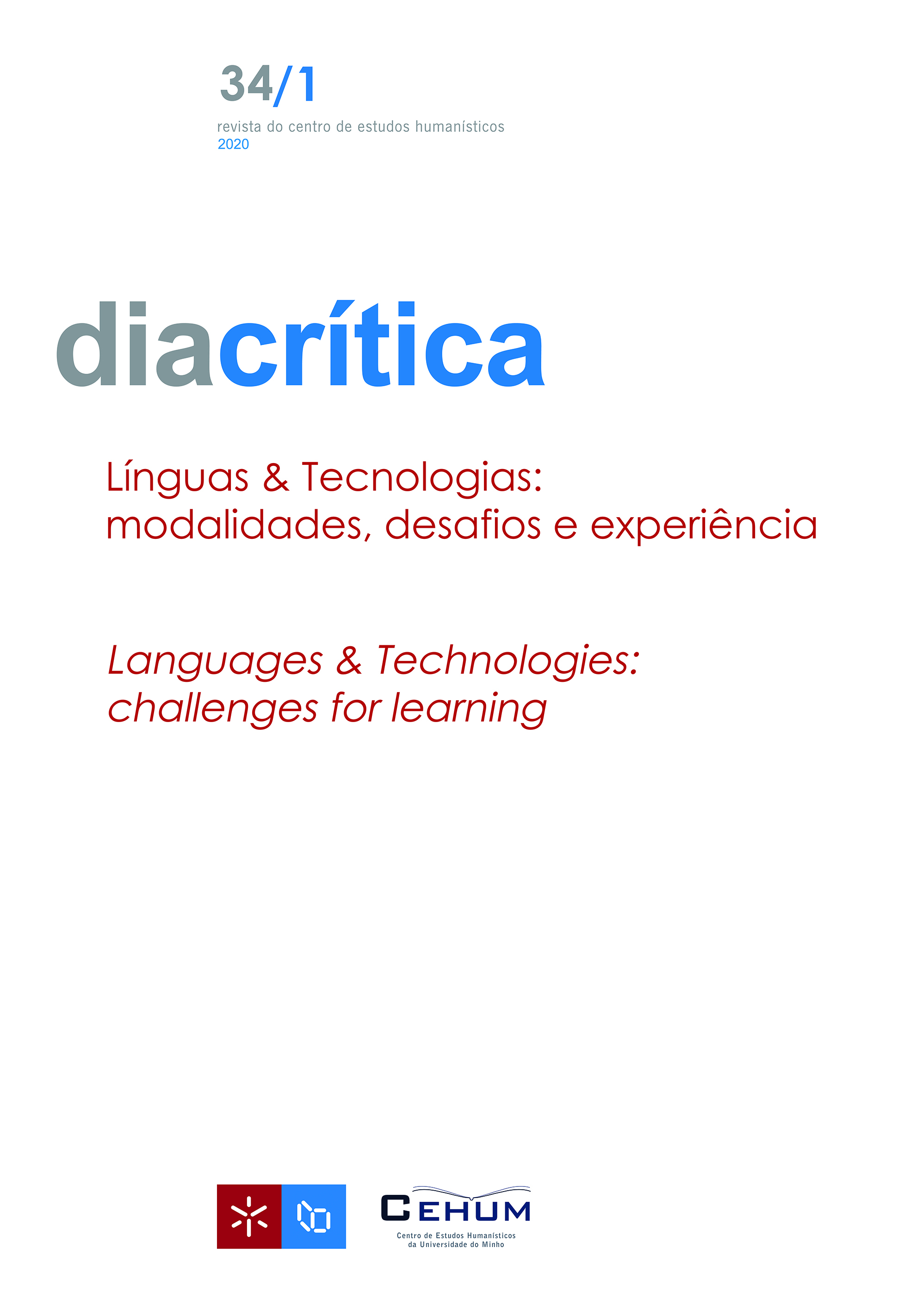L2 vocabulary instruction: An analysis of smartphone applications for English learning
DOI:
https://doi.org/10.21814/diacritica.4970Keywords:
Vocabulary Instruction, Mobile Learning, Second Language Learning, Smartphone ApplicationsAbstract
Smartphones have become more accessible n the last decade, which has promoted the development of numerous applications for language learning and brought increased interest in the field of Mobile Assisted Language Learning (MALL). Considering that most smartphone applications for English learning have activities designed to instruct vocabulary, this study aimed to analyze the instruction of vocabulary in the three most used applications for language learning until the end of 2018. More specifically, it investigated: a) what aspects of word-knowledge the applications develop; b) whether they provide a number of encounters with the target vocabulary and whether they are massed or spaced; and c) the nonverbal representations employed by the applications. The results showed that the applications: a) instruct the spoken and written form of words, but often neglect other aspects of word knowledge such as the lexical and syntactic relations between words; b) provide multiple, massed encounters with the target vocabulary and c) employ images and videos as nonverbal that are not always relevant to the instruction of target vocabulary. Based on our analysis we concluded that, in spite of limitations such as the lack of opportunities for language production and decontextualized instruction, these applications can be used as a tool to assist the instruction of vocabulary.
References
Attewell, J. & Savill-Smith, C. (2003). M-learning and social inclusion – focusing on learners and learning. Proceedings of MLEARN 2003: Learning with Mobile Devices, 3–12. London: Learning and Skills Development Agency.
Andrade, I. R. (2017). Aprendizagem de língua assistida por Dispositivos móveis (ALADIM): uma proposta alternativa para o ensino da língua espanhola (Unpublished PhD thesis, Unicamp, Campinas, Brasil).
Bahrick, H. P. & Phelps, E. (1987). Retention of Spanish vocabulary over 8 years. Journal of Experimental Psychology: Learning, Memory and Cognition, 4, 316–321. DOI: https://doi.org/10.1037/0278-7393.13.2.344
Bloom, K. C. & Shuell, T. J. (1981). Effects of massed and distributed practice on the learning and retention of second-language vocabulary. Journal of Educational Research. 74, 245–248. DOI: https://doi.org/10.1080/00220671.1981.10885317
BuzzFeedPress. (2017). BuzzFeed expands internationally in partnership with Duolingo. <https://www.buzzfeed.com/buzzfeedpress/buzzfeed-expands-internationally-in-partnership-with-duoling?utm_term=.koE4Kq0Z#.eoXw6nk8>. Consulted on: 6th Mar. 2017.
Carter, R. (2012). Vocabulary: applied linguistic perspectives. Abingdon, Oxon: Routledge. DOI: https://doi.org/10.4324/9780203124659
Chapelle, C. & Jamieson, J. (2008). Tips for teaching with CALL: Practical approaches to computer-assisted language learning. New York: Pearson Education.
Chinnery, G. M. (2006). Going to the mall: mobile assisted language learning. Language Learning & Technology, 10, 9–16.
Clark, J. & Paivio, A. (1991). Dual Coding Theory and Education. Educational Psychology Review, 3 (3), 149–210. DOI: https://doi.org/10.1007/BF01320076
Garcia, I. (2013). Learning a language for free while translating the Web. Does Duoliongo work? International Journal of English Linguistics, 3, 19–25. DOI: https://doi.org/10.5539/ijel.v3n1p19
Goossens, N., Camp, G., Verkoeijen, P., Tabbers, H. & Zwaan, R. (2012). Spreading the words: A spacing effect in vocabulary learning. Journal of Cognitive Psychology, 24. 965-971. DOI: https://doi.org/10.1080/20445911.2012.722617
Hatch, E. & Brown, C. (1995). Vocabulary, Semantics and Language Education. New York: Cambridge University Press.
Kim, H. & Kwon, Y. (2012). Exploring smartphone applications for effective mobile-assisted language learning. Multimedia-Assisted Language Learning, 15 (1), 31–57. DOI: https://doi.org/10.15702/mall.2012.15.1.31
Laufer, B. (1997). What's in a word that makes it hard or easy: some intralexical factors that affect the learning of words. In N. Schmidtt & M. McCarthy (Eds.), Vocabulary Description, Acquisition and Pedagogy (pp. 154–160). Cambridge: Cambridge University Press.
Laufer, B. (2017). The Three ‘I’s of second language vocabulary learning: Input, instruction, involvement. In E. Hinkel (Ed.), Handbook of research in second language teaching and learning, 3, (pp. 343–354). London: Routledge. DOI: https://doi.org/10.4324/9781315716893-25
Levy, M. (1997). Computer-assisted language learning: context and contextualization. Oxford: Oxford University Press.
Lewis, M. (1993). The lexical approach. Hove and London: Language teaching publications.
Mayer, R. (2009). Multimedia Learning. New York: Cambridge University Press. DOI: https://doi.org/10.1017/CBO9780511811678
Meara, P. (1980). Vocabulary acquisition: A neglected aspect of language learning. Language Teaching and Linguistics Abstracts, 13, 221–246. DOI: https://doi.org/10.1017/S0261444800008879
Naismith, L. (2004). Literature review in mobile technologies and learning. Bristol: Nesta Futurelab.
Nation, I. S. P. (1990). Teaching and learning vocabulary. Boston: Heinle & Heinle Publishers.
Nation, I. (2001). Learning Vocabulary in Another Language. Cambridge: Cambridge University Press. DOI: https://doi.org/10.1017/CBO9781139524759
Sadoski, M. (2005). A Dual Coding View of Vocabulary Learning. Reading & Writing Quarterly: Overcoming Learning Difficulties, 21, 221–238. <http://dx.doi.org/10.1080/10573560590949359>. Consulted on: 16th Dec. 2018. DOI: https://doi.org/10.1080/10573560590949359
Settles, B. & Meeder, B. (2016). A Trainable Spaced Repetition Model for Language Learning. Proceedings of the 54th Annual Meeting of the Association for Computational Linguistics. 1848–1858. DOI: https://doi.org/10.18653/v1/P16-1174
Schmitt, N. (2000). Vocabulary in language teaching. Cambridge: Cambridge University Press
Sökmen, A. J. (1997). Current trends in teaching second language vocabulary. In N. Schimitt & M. McCarthy (Eds.), Vocabulary: Description, Acquisition and Pedagogy (pp. 237–257). Cambridge: Cambridge University Press.
Stimac, B. (2014). Google Play Store now showcases app download numbers with new badges. <https://www.greenbot.com/article/2463910/google-play-store-now-showcases-app-download-numbers-with-new-badges.html>. Consulted on: 22nd Nov. 2018.
Stockwell, G. (2010). Using mobile phones for vocabulary activities: examining the effect of the platform. Language Learning & Technology, 14, 95–110.
Stockwell, G. & Hubbard, P. (2013). Some emerging principles for mobile-assisted language learning. The International Research Foundation for English Language Education. <http://www.tirfonline.org/english-in-the-workforce/mobile-assisted-language-learning>. Consulted on: 22nd Nov. 2018.
Ullman, M. & Lovelett, J. T. (2016). Implications of the declarative/procedural model for improving second language learning: The role of memory enhancement techniques. Second language research, 1, 1–27. DOI: https://doi.org/10.1177/0267658316675195
Vesselinov, R. & Grego, J. (2012). Duolingo effectiveness study. <http://comparelanguageapps.com/documentation/DuolingoReport_Final.pdf>. Consulted on: 15th Dec. 2018.
Vekiri, I. (2002). What Is the Value of Graphical Displays in Learning? Educational Psychology Review, 14 (3), 261–312. DOI: https://doi.org/10.1023/A:1016064429161
Downloads
Published
How to Cite
Issue
Section
License
Copyright (c) 2023 Daniel Reschke Pires, Celso Henrique Soufen Tumolo

This work is licensed under a Creative Commons Attribution-NonCommercial 4.0 International License.










